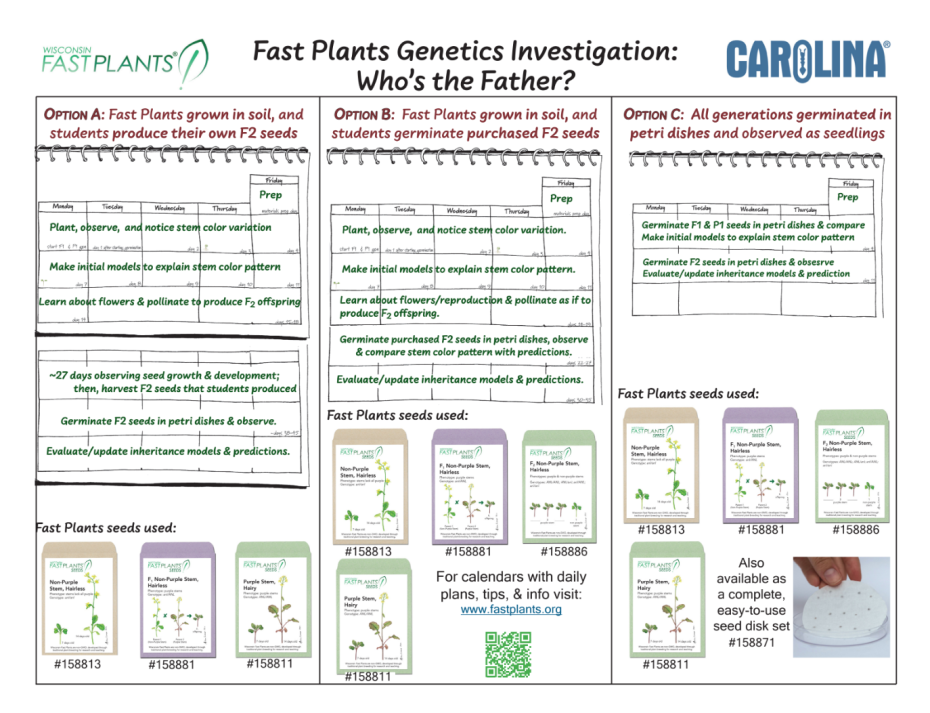Are you just deciding where to start to teach inheritance patterns with Fast Plants? Or maybe you’ve used Fast Plants before and are ready to add complexity to your inheritance investigations. Because we have so many resources available, choosing where to start can be a bit daunting. So, in this post we guide you through the decision making process and link to key resources, including:
- Three reasons for using Fast Plants to teach inheritance
- Choosing an inheritance investigation that fits your schedule and learning goals
- Choosing which Fast Plants seed varieties will work best for what you want to teach
- How to start? Choosing an ideal growing system for your classroom
Why are Fast Plants an excellent model organism for teaching heredity? Because learning about inheritance with worksheets and Punnett squares can lack engagement, and students can learn more conceptually with hands-on inheritance investigations! In addition, developing inheritance models with Fast Plants sets the stage for rigorous, Three Dimensional learning as described by the Next Generation Science Standards. For these reasons and more, Fast Plants make an excellent model organism for interactive lessons about inheritance and genetics.
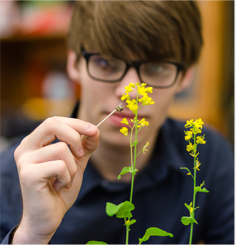
Three reasons for using Fast Plants to teach inheritance and genetics
- Sexual reproduction in Fast Plants is easy to observe firsthand. In addition, when Fast Plants flower, students assist in reproduction. In just two weeks after planting, Fast Plants mature and flower. During pollination, students use bee sticks (or something similar) to transfer pollen from flowers on one plant to another.
- Fast Plants rarely self pollinate. So, if pollen from one flower on a plant falls on the stigma of a flower on the same plant, no fertilization takes place. This means that reproduction in Fast Plants is similar to sexual reproduction in most animals, making them a powerful and easy-to-relate-to heredity model.
- Fast Plants are fast and easy to grow and won’t get loose in your school like fruit flies. Also, teaching inheritance with Fast Plants can be done in lots of different ways–some in as few as 72 hours! Continue reading to find the option that best fits your schedule and learning goals.
Where to start with Fast Plants and teaching inheritance is a great question with real-life and culturally relevant beginnings. Firstly, and most naturally, we can start with the produce aisle in any grocery store. Here, we see many vegetables from the Brassica family. And noticing the amazing variation in all these Brassicas we eat is a great foundation for investigating inheritance and genetics.
Choosing an inheritance investigation that fits your schedule and learning goals
An inheritance investigation with Wisconsin Fast Plants can be customized to fit your classroom, based on your learning goals and the available timeframe for conducting the investigation.
Wisconsin Fast Plants’ seed varieties offer both mono- and dihybrid inheritance options to teach inheritance. So, what is the advantage of a monohybrid or a dihybrid inheritance pattern? Simply put, we can choose to use mono- vs. dihybrid inheritance patterns depending on the pattern complexity we want students to explain. Monohybrid, dominant/recessive allele inheritance patterns are great for yielding evidence similar to what Mendel used to make profound genetic inferences. However, choosing to investigate a dihybrid inheritance pattern can be an effective strategy for challenging students to more purposefully make sense of underlying genetics processes.
After choosing between a Monohybrid or Dihybrid investigation, consider the timeframe available in your classroom and choose between the following investigation timeframe options.
- Option A — approximately 6-8 weeks
- Fast Plants parental and F1 varieties are grown in soil, heritable phenotypes are observed, and students pollinate F1 plants to produce their own F2 seeds. When F2 seeds mature, they are harvested, planted/germinated, and F2 seedling phenotypes are observed.
- Option B — approximately 3-5 weeks
- Fast Plants parental and F1 varieties are grown in soil and heritable phenotypes are observed. Students pollinate F1 plants, but instead of waiting for seeds to mature, time is saved when F2 seeds are purchased, planted/germinated, and used to observe F2 seedling phenotypes.
- Option C — approximately 3-5 days
- All Fast Plants generations are germinated in Petri dishes and observed as seedlings. Phenotypes can be observable after 72 hours. No planting and no special lighting required!
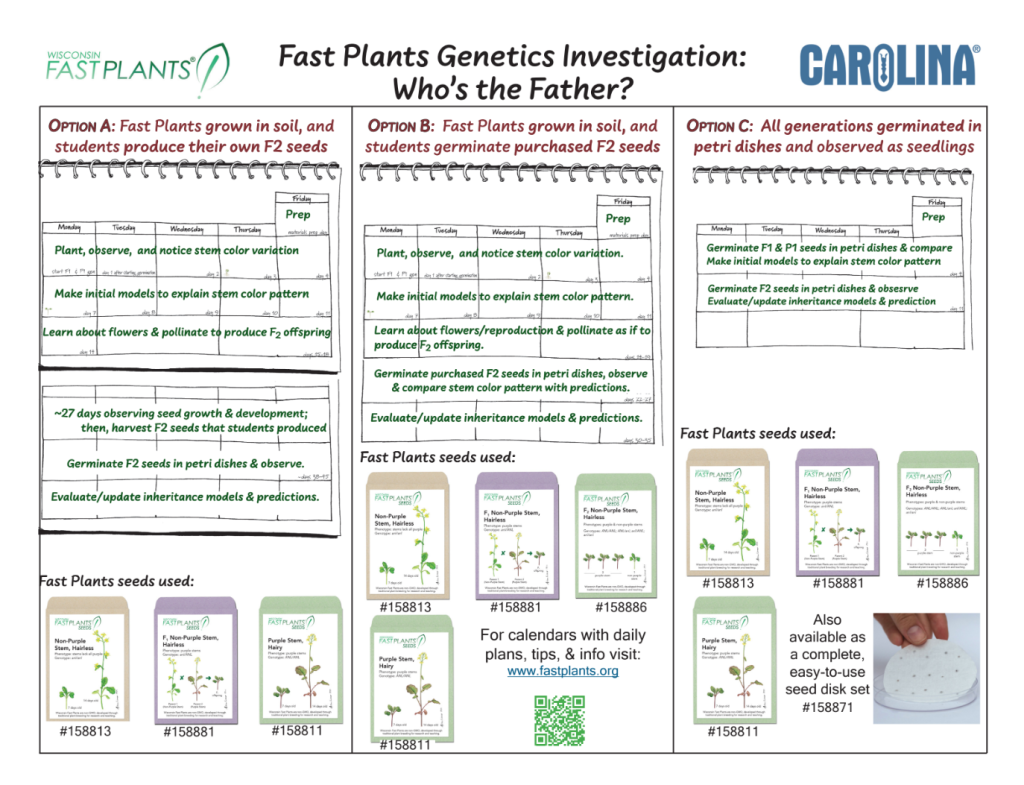
Note that this graphic features seed varieties for teaching a Monohybrid Inheritance investigation, with stem color traits.
Choosing which Fast Plants seed varieties will work best for what you want to teach
- Monohybrid – Stem Color
- Dihybrid – Plant Stature and Stem Color
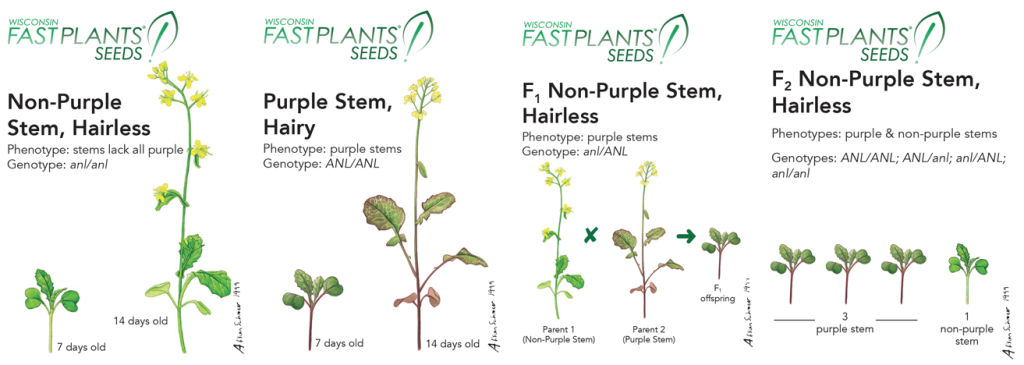
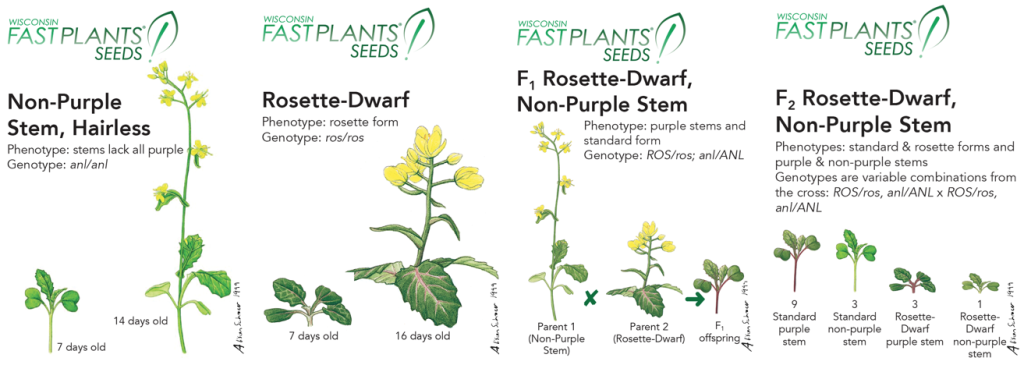
Now, let’s think back to the different potential timeframes to teach inheritance investigations. Monohybrid and dihybrid investigations are possible using any of the Options A, B, C, described above. For options A and B, no matter whether you’re conducting a monohybrid or dihybrid investigation, the protocols will be similar, the difference is in the phenotypes that students will observe. However, for option C protocols will differ slightly. Monohybrid investigations can utilize the easy-to-use, complete seed disk set for simple setup and observation of seedlings. Dihybrid seed varieties are not available in seed disks, thus seeds must be manually placed onto wet paper towel in Petri dishes.
Listed below is an alternative for a Dihybrid investigation. This investigation uses the Yellow-Green Leaf trait, which does not express well (i.e. it cannot be distinguished) in a Petri dish. Therefore, genetics investigations with Yellow-Green Leaf need to utilize plants grown in soil. They can be conducted using Options A or B described above, but require that seeds be germinated in soil instead of in a Petri dish for Option B, offspring generation.
- Dihybrid – Leaf Color and Stem Color

How to start? Choosing an ideal growing system for your classroom
Whether you’re using a ready-to-go growing system kit or a DIY growing system solution, Fast Plants are easy to grow in a variety different growing systems. To be successful, a Fast Plants growing system should provide continuous moisture (via wicking), utilize a soil-free potting mix, and be placed under continuous, 24-hour, light of sufficient intensity. Check out this video for a short overview of three popular, time-tested growing systems. After that, continue watching this playlist for detailed planting guides in different growing systems. Finally, check out the Preparation page for links to DIY guides for popular growing systems. Now, get growing! 🌱

